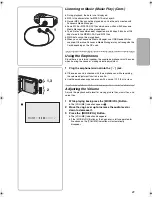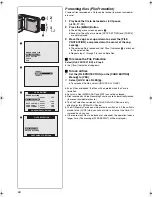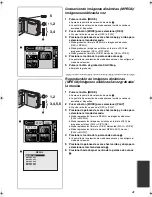
31
ª
Using a Card in a Personal Computer
≥
To erase pictures that you recorded on the Card by
using the SD Multi AV Device, be sure to erase them on
the SD Multi AV Device, not on the computer.
≥
You may not be able to properly play back on the SD
Multi AV Device after editing the recorded data or
changing the image data on a personal computer.
≥
The image data files recorded on the Card with this SD
Multi AV Device conform to the DCF (Design Rules for
Camera Files Systems) universal standard stipulated by
JEITA (Japan Electronics and Information Technology
Industries Association).
≥
Moving Picture format (MPEG4) that can be played back
on this device is ASF. (Depending on the file, it may not
be able to be played back even if it is in ASF format.)
Constructing a Folder when the Card is used
with a PC
≥
When a Card with data recorded on it is inserted into a
personal computer, folders will be displayed as in the
figure.
[100cdpfp]:
The images (imga0001.jpg etc.) in this
folder are recorded in the JPEG
format.([100-0001] or similar indication is
displayed on the SD Multi AV Device.)
[Misc]:
Files in which DPOF Data has been set to
the image are in this.
[SD_VC100] Folder in which the voice data (e.g.,
MOB001.VM1) files are stored.
[SD_AUDIO] Folder in which the music data (e.g.,
AOB001.SA1) files recorded by the
Panasonic Media Manager (supplied
accessory) are stored.
[PRL001]:
MPEG4 moving picture is recorded in
ASF format (MOL001.ASF etc.). It can be
played back with Windows Media Player
(ver.6.4 and later). Because of small size,
this File is well suited for transmitting data
through a telephone line etc.
≥
[DCIM], [IM01CDPF], [SD_VIDEO], [SD_VOICE] etc.
are necessary items in the folder structure. They have
nothing to do with actual operations.
≥
The SD Multi AV Device automatically saves file
numbers (imga0001.jpg, etc.) along with the images.
The file numbers are recorded with each image as a
consecutive number.
≥
The memory capacity indicated on the SD Card label
corresponds to the total amount of the capacity to
protect and manage the copyright and of the capacity
available as a conventional memory for a SD Multi AV
Device, Personal Computer or others. Capacity that can
be used as conventional memory:
64MB Card:
about 63,570,000 bytes
≥
The [SD_VOICE] folder, the voice files contained in it,
and [SD_AUDIO] folder are specified to the hidden files.
Those folders and files may not be displayed on the
Explore and My Computer screen depending on the
setting of your PC.
≥
Do not delete any folders located on the Card. If this is
done, the Card may not be recognized on your SD Multi
AV Device.
≥
The MPEG 4 moving picture file (ASF format) can be
played on the Windows
®
Media Player (Ver. 6.4 or later).
If it cannot be played back, download the appropriate
software (G.726). The Windows
®
Media Player contains
the auto-downloading feature of this software. Log on
the Internet and double-click the MPEG 4 moving picture
file. The software will be downloaded automatically.(To
play back a file on Mac OS
®
, Windows Media Player for
Macintosh
®
is required.)
≥
When formatting a Card, format it on the SD Multi AV
Device or on Panasonic Media Manager.
≥
When a moving picture is played back on a personal
computer, a black belt may be present along the top and
bottom of the picture.
≥
If data not supported by the SD Multi AV Device is
recorded on a personal computer, it cannot be
recognized by the SD Multi AV Device.
SDV1U.book 31 ページ 2002年2月15日 金曜日 午後9時44分














































